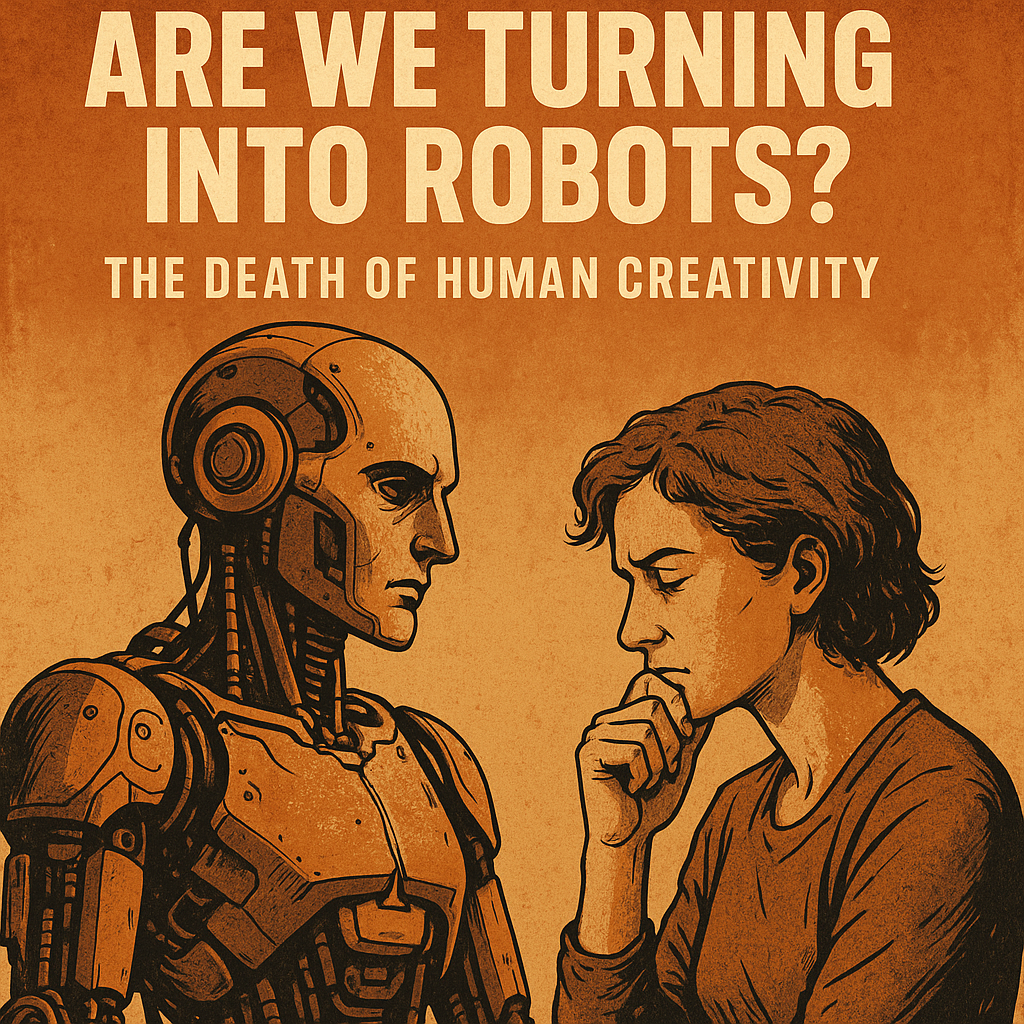Introduction: Have We Traded Wonder for Wires?
Have you ever sat in a café, watching people stare blankly into their phones, barely interacting with each other? Once, we filled those moments with sketching on napkins, deep conversation, or spontaneous daydreaming. Today, it’s endless scrolling, mindless clicking, and a growing void of originality.
Are we turning into robots? The death of human creativity might sound dramatic, but it’s a very real concern in a world where technology is accelerating faster than our capacity to stay human. We’re more connected yet more creatively disconnected. But what’s really causing this shift—and can we reverse it?
The Rise of Automation: Convenience or Confinement?
When Algorithms Think for Us
We live in a time when recommendation engines suggest what to watch, read, wear, and even think. Netflix picks our next binge, Spotify curates our moods, and ChatGPT can write our emails. While these tools are undeniably convenient, they can also dull our creative muscles.
Key insight: The more machines think for us, the less we are required to think for ourselves.
In his book “The Shallows: What the Internet Is Doing to Our Brains”, Nicholas Carr argues that constant digital multitasking rewires our brains, reducing our ability to engage in deep, reflective thinking—an essential foundation of creativity.
Creativity vs. Conformity: The Battle Within
From Unique Expression to Trend Replication
Scroll through Instagram or TikTok and you’ll quickly see that originality is often sacrificed for what’s trending. Filters homogenize our faces. Content creators copy viral formats. AI tools generate art based on prompts rather than passion.
| Creative Force | Robotically Influenced Behavior |
|---|---|
| Writing personal stories | Generating AI-written content |
| Creating original art | Using presets and templates |
| Composing new music | Remixing auto-generated loops |
| Problem-solving with nuance | Following how-to templates blindly |
We’re not just outsourcing tasks—we’re outsourcing our imagination.
The Workplace: Efficiency Killing Innovation?
Metrics Over Meaning
In many corporate environments, employees are rewarded for speed and output—not for pushing boundaries. Meetings are filled with slides, KPIs, and dashboards, leaving little room for the kind of play that sparks innovation.
Example: Google’s once-revered “20% time”—a policy allowing employees to explore passion projects—was responsible for innovations like Gmail. But over time, it became marginalized in favor of deadlines and deliverables.
Key Insight: Creativity often thrives in chaos and freedom, not in spreadsheets and structure.
The Role of AI: Partner or Predator?
Artificial Intelligence Is Amazing—But at What Cost?
AI tools can now generate art, music, essays, even jokes. And while some see AI as a creative assistant, others fear it’s making creators obsolete.
-
A 2023 study by McKinsey found that AI could automate up to 30% of creative jobs by 2030, especially in content creation, marketing, and design.
-
AI-generated books and artworks are now flooding platforms like Amazon and Etsy, often indistinguishable from human creations.
But here’s the twist: AI lacks emotion. It can’t feel heartbreak, wonder, fear, or love. It simulates creativity but can’t embody it.
Quote to Consider:
“AI can paint a picture, but it can’t feel the joy of painting it.” – Anonymous
Is It All Bad News? Rediscovering Human Creativity
The Creative Rebellion Has Begun
Despite the noise, many creators are pushing back. The handmade, the imperfect, and the analog are regaining value.
-
Vinyl records are resurging.
-
Hand-drawn illustrations are in demand.
-
Indie films and podcasts are finding loyal, engaged audiences.
These trends show that authentic human creativity still has a pulse—it just needs a platform, and a little breathing room.
What Can You Do?
Here’s how to keep your creativity alive in a robotic world:
-
Unplug regularly: Go for a walk without your phone. Let your mind wander.
-
Create without a goal: Paint, write, or sing just for fun—not for likes.
-
Embrace boredom: It’s often the birthplace of big ideas.
-
Consume less, create more: Don’t just scroll—sketch, journal, build, bake.
Internal & External Influences: How We Got Here
From Education to Social Media
Education Systems:
Most schools still emphasize memorization over imagination. Creativity isn’t tested on standardized exams, so it’s sidelined.
Social Media:
Validation now comes in the form of likes and shares. This encourages sameness and safe content over risk-taking and originality.
Tech Dependency:
As tech solves more problems for us, we lose the urge to invent our own solutions.
Suggested Read: Why Creativity Is the New Currency in the Digital Age
Are We Turning Into Robots? Not Yet—If We Choose Otherwise
The Final Thought
No, we’re not robots—yet. But we’re dangerously close if we continue to trade our curiosity for convenience. The death of human creativity isn’t inevitable. It’s a choice—a consequence of the tools we use, the values we uphold, and the lives we design.
Let’s remember:
-
Creativity is a muscle. Use it or lose it.
-
Technology is a tool, not a substitute for imagination.
-
Being human is messy, emotional, spontaneous—and that’s the magic.
Call to Action: Time to Think Like a Human Again
So, what will you do today to reclaim your creativity?
👉 Tell us in the comments how you stay inspired in a tech-driven world.
👉 Or explore our curated list of offline creativity boosters and get your imagination flowing again.
👉 Want more insight like this? Subscribe to our newsletter for weekly tips on staying human in a digital world.
Internal Links:
External Links:

